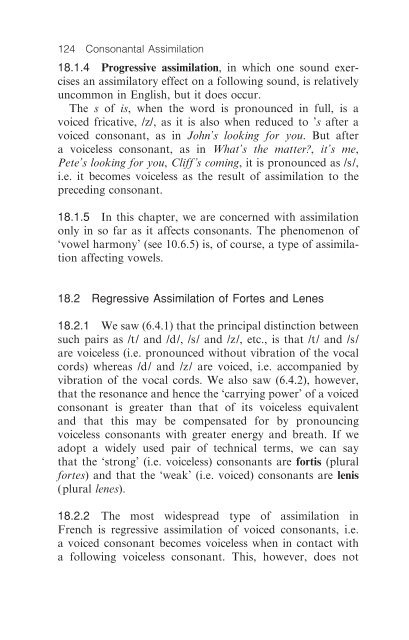An Introduction to French Pronunciation
An Introduction to French Pronunciation
An Introduction to French Pronunciation
Create successful ePaper yourself
Turn your PDF publications into a flip-book with our unique Google optimized e-Paper software.
124 Consonantal Assimilation<br />
18.1.4 Progressive assimilation, in which one sound exercises<br />
an assimila<strong>to</strong>ry effect on a following sound, is relatively<br />
uncommon in English, but it does occur.<br />
The s of is, when the word is pronounced in full, is a<br />
voiced fricative, /z/, as it is also when reduced <strong>to</strong> ’s after a<br />
voiced consonant, as in John’s looking for you. But after<br />
a voiceless consonant, as in What’s the matter?, it’s me,<br />
Pete’s looking for you, Cliff’s coming, it is pronounced as /s/,<br />
i.e. it becomes voiceless as the result of assimilation <strong>to</strong> the<br />
preceding consonant.<br />
18.1.5 In this chapter, we are concerned with assimilation<br />
only in so far as it affects consonants. The phenomenon of<br />
‘vowel harmony’ (see 10.6.5) is, of course, a type of assimilation<br />
affecting vowels.<br />
18.2 Regressive Assimilation of Fortes and Lenes<br />
18.2.1 We saw (6.4.1) that the principal distinction between<br />
such pairs as /t/ and /d/, /s/ and /z/, etc., is that /t/ and /s/<br />
are voiceless (i.e. pronounced without vibration of the vocal<br />
cords) whereas /d/ and /z/ are voiced, i.e. accompanied by<br />
vibration of the vocal cords. We also saw (6.4.2), however,<br />
that the resonance and hence the ‘carrying power’ of a voiced<br />
consonant is greater than that of its voiceless equivalent<br />
and that this may be compensated for by pronouncing<br />
voiceless consonants with greater energy and breath. If we<br />
adopt a widely used pair of technical terms, we can say<br />
that the ‘strong’ (i.e. voiceless) consonants are fortis (plural<br />
fortes) and that the ‘weak’ (i.e. voiced) consonants are lenis<br />
(plural lenes).<br />
18.2.2 The most widespread type of assimilation in<br />
<strong>French</strong> is regressive assimilation of voiced consonants, i.e.<br />
a voiced consonant becomes voiceless when in contact with<br />
a following voiceless consonant. This, however, does not












